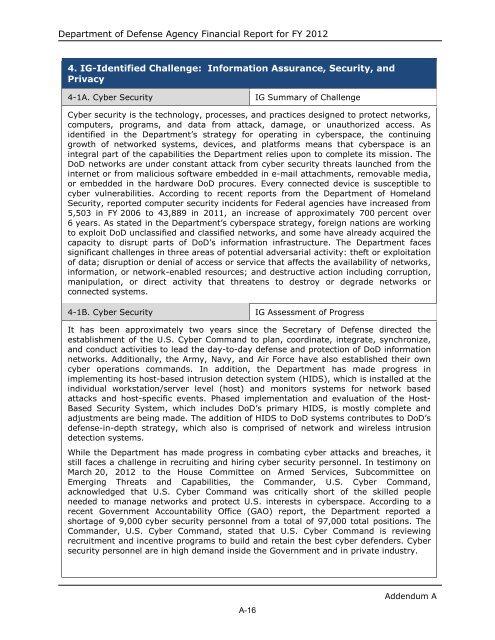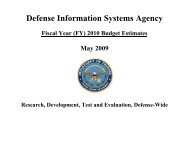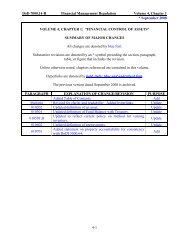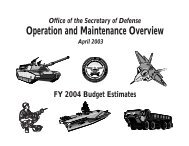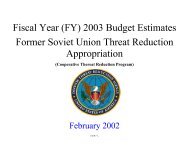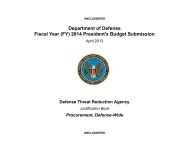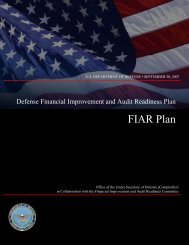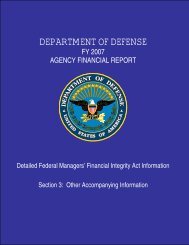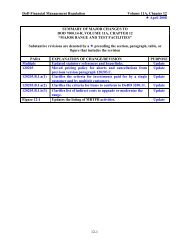department of defense agency financial report fiscal year 2012
department of defense agency financial report fiscal year 2012
department of defense agency financial report fiscal year 2012
Create successful ePaper yourself
Turn your PDF publications into a flip-book with our unique Google optimized e-Paper software.
Department <strong>of</strong> Defense Agency Financial Report for FY <strong>2012</strong><br />
4. IG-Identified Challenge: Information Assurance, Security, and<br />
Privacy<br />
4-1A. Cyber Security IG Summary <strong>of</strong> Challenge<br />
Cyber security is the technology, processes, and practices designed to protect networks,<br />
computers, programs, and data from attack, damage, or unauthorized access. As<br />
identified in the Department’s strategy for operating in cyberspace, the continuing<br />
growth <strong>of</strong> networked systems, devices, and platforms means that cyberspace is an<br />
integral part <strong>of</strong> the capabilities the Department relies upon to complete its mission. The<br />
DoD networks are under constant attack from cyber security threats launched from the<br />
internet or from malicious s<strong>of</strong>tware embedded in e-mail attachments, removable media,<br />
or embedded in the hardware DoD procures. Every connected device is susceptible to<br />
cyber vulnerabilities. According to recent <strong>report</strong>s from the Department <strong>of</strong> Homeland<br />
Security, <strong>report</strong>ed computer security incidents for Federal agencies have increased from<br />
5,503 in FY 2006 to 43,889 in 2011, an increase <strong>of</strong> approximately 700 percent over<br />
6 <strong>year</strong>s. As stated in the Department’s cyberspace strategy, foreign nations are working<br />
to exploit DoD unclassified and classified networks, and some have already acquired the<br />
capacity to disrupt parts <strong>of</strong> DoD’s information infrastructure. The Department faces<br />
significant challenges in three areas <strong>of</strong> potential adversarial activity: theft or exploitation<br />
<strong>of</strong> data; disruption or denial <strong>of</strong> access or service that affects the availability <strong>of</strong> networks,<br />
information, or network-enabled resources; and destructive action including corruption,<br />
manipulation, or direct activity that threatens to destroy or degrade networks or<br />
connected systems.<br />
4-1B. Cyber Security IG Assessment <strong>of</strong> Progress<br />
It has been approximately two <strong>year</strong>s since the Secretary <strong>of</strong> Defense directed the<br />
establishment <strong>of</strong> the U.S. Cyber Command to plan, coordinate, integrate, synchronize,<br />
and conduct activities to lead the day-to-day <strong>defense</strong> and protection <strong>of</strong> DoD information<br />
networks. Additionally, the Army, Navy, and Air Force have also established their own<br />
cyber operations commands. In addition, the Department has made progress in<br />
implementing its host-based intrusion detection system (HIDS), which is installed at the<br />
individual workstation/server level (host) and monitors systems for network based<br />
attacks and host-specific events. Phased implementation and evaluation <strong>of</strong> the Host-<br />
Based Security System, which includes DoD’s primary HIDS, is mostly complete and<br />
adjustments are being made. The addition <strong>of</strong> HIDS to DoD systems contributes to DoD’s<br />
<strong>defense</strong>-in-depth strategy, which also is comprised <strong>of</strong> network and wireless intrusion<br />
detection systems.<br />
While the Department has made progress in combating cyber attacks and breaches, it<br />
still faces a challenge in recruiting and hiring cyber security personnel. In testimony on<br />
March 20, <strong>2012</strong> to the House Committee on Armed Services, Subcommittee on<br />
Emerging Threats and Capabilities, the Commander, U.S. Cyber Command,<br />
acknowledged that U.S. Cyber Command was critically short <strong>of</strong> the skilled people<br />
needed to manage networks and protect U.S. interests in cyberspace. According to a<br />
recent Government Accountability Office (GAO) <strong>report</strong>, the Department <strong>report</strong>ed a<br />
shortage <strong>of</strong> 9,000 cyber security personnel from a total <strong>of</strong> 97,000 total positions. The<br />
Commander, U.S. Cyber Command, stated that U.S. Cyber Command is reviewing<br />
recruitment and incentive programs to build and retain the best cyber defenders. Cyber<br />
security personnel are in high demand inside the Government and in private industry.<br />
A-16<br />
Addendum A


